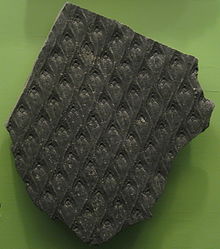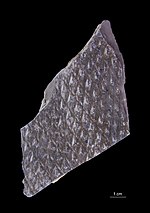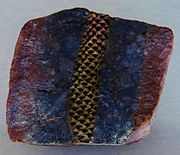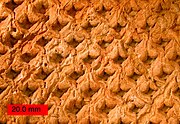Lepidodendron
| Lepidodendron Temporal range:
| |
|---|---|

| |
| Trunk fragment, showing leaf base scars | |
| Scientific classification | |
| Kingdom: | Plantae |
| Clade: | Tracheophytes |
| Clade: | Lycophytes |
| Class: | Lycopodiopsida |
| Order: | †Lepidodendrales |
| Family: | †Lepidodendraceae |
| Genus: | †Lepidodendron Sternberg, 1820 |
| Species | |
| |
| Synonyms | |
| |
Lepidodendron is an
Etymology
The name Lepidodendron comes from the Greek λεπίς lepis, scale, and δένδρον dendron, tree.
Description and biology
Overview


Lepidodendron species were comparable in size to modern trees. The plants had tapering trunks as wide as 2 m (6.6 ft) at their base that rose to about 40 m (130 ft)[2] and even 50 m (160 ft),[1] arising from an underground system of horizontally spreading branches that were covered with many rootlets. Though the height of the lycopsids make the plants similar to modern trees, the constant dichotomy of branches created a habit that contrasts with that of modern trees. At the ends of branches were oval-shaped strobili called Lepidostrobus that had a similar shape to modern cones of a spruce or fir.[3]
Stem

The stem of the lycopsids had a
Leaves

The leaves of the lycopsid were needle-like and were densely spiraled about young shoots, each possessing only a single
Underground Structures
The underground structures of Lepidodendron and similar lycopsid species known from the fossil record including
Decay

Different fossil genera have been described to name the various levels of decay in Lepidodendron bark fossils. The name Bergeria describes stems that have lost their epidermises, Aspidiariu is used when cushions have been removed by deep decay, and Knorria is used when the leaf cushions and the majority of cortical tissues has decayed, with a shallow "fluted" surface remaining. However, it has been suggested that these are more likely growth forms than preserved bark types, as entire fossilized trunks have been discovered with dissimilar forms; if decay is assumed to be constant throughout the trunk, then different forms indicate growth rather than levels of decay. It is likely that the trunk of Lepidodendron lycopsids were subject to the growth forms Knorria, Aspidiaria, and Bergeria progressing up the trunk, respectively.[8]
Growth and reproduction

During the early stages of growth, Lepidodendron grew as single, unbranched trunk, with leaves growing out of the scale leaf bases (cushions). Towards the end of the lycopod growth, the leaves on the lower part of the trunk were shed, and in Lepidodendron, the upper part of the trunk
Distribution
The lack of
Extinction
In
Gallery
-
Lepidodendron sp. bark from thePottsville Group, Lower Pennsylvanian
-
Lepidodendron elegans
-
Lepidodendron aculeatum
-
Lepidodendron lycopodioides
-
Life restoration
-
Restoration of Lepidodendron with leafy branches
-
Lepidodendron bark from Joggins, Nova Scotia, Canada
-
Lepidodendron fossil stumps from Fossil Grove, Glasgow, Scotland
-
Lepidodendron sp. stem impression displayed at a collection held in the National Museum of Brazil
-
Various Lepidodendron diagrams from the Geological Survey of Pennsylvania
-
External mold of Lepidodendron from theUpper Carboniferous of Ohio.
-
1911 reconstruction of a mature Lepidodendron, showing dichotomous branching at the top of the trunk
See also
- Archaeopteris
- Carboniferous
- Evolutionary history of plants
- Fossil Grove
- Glossopteris
- Lepidodendrales
- Lycophytes
- Lycopsid
- Stigmaria
- Sigillaria
References
- ^ a b V. V. Alekhin (1961). Geografiia rastenii s osnovani botaniki (Geography of plants and basics of botany). Gos. nauchno-pedagog. izd-vo. p. 167. Retrieved 2020-10-05.
- ^
A. V. Lopatin (2012). Палеонтологический музей имени Ю.А. Орлова (The Orlov Museum of Paleontology). Moscow: PIN RAN. p. 56. ISBN 978-5-903825-14-1. Retrieved 2020-10-05.
- ^ a b c Seward, Albert Charles (1898). Fossil plants: for students of botany and geology. Vol. 1. Cambridge University Press. pp. 93–192.
- ^ a b Vulf, Evgenii Vladimirovich and Brissenden, Elizabeth (1943). An introduction to historical plant geography. Chronica Botanica Company. pp. 176–177.
{{cite book}}: CS1 maint: multiple names: authors list (link) - ISBN 9780226580838.
- PMC 4914198.
- .
- doi:10.1002/gj.3350110102.)
{{cite journal}}: CS1 maint: multiple names: authors list (link - ^ PMID 29282734.
- ISBN 9780472082803.
- ^ ISSN 2524-4507.
- ISSN 0305-8719.
- .
Further reading
- Davis, Paul; Kenrick, Paul (2004). Fossil Plants. Washington, DC: Smithsonian Books. ISBN 1-58834-181-X.
- Morran, Robin C. (2004). A Natural History of Ferns. Portland: Timber Press. ISBN 0-88192-667-1.
- "Plant fossils of the British Coal Measures" by Christopher J.Cleal and Barry A.Thomas, publ. The Palaeontological Association, London, 1994, 222 pages, ISBN 0-901702-53-6
- J. M. Anderson and H. M. Anderson. 1985. Palaeoflora of Southern Africa. Prodromus of South African Megafloras Devonian to Lower Cretaceous 1-423












